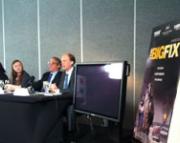Filmmakers Share Truths Uncovered in New Documentary, "The Big Fix"
Listen to the full audio story
- 20113-11-08oil.mp3

Rebecca Harrell Tickell, Co-Director and Producer of the documentary "The Big Fix", spent 18 months filming in the Gulf of Mexico.
She was told by local officials that the air and water was not dangerous.
In fact, they wouldn't allow her to wear respirators because they were nervous it would make it seem like there was something to fear.
Shortly after she and her husband began filming, Tickell noticed her skin peeling off her feet. She developed blisters on her neck and back and spent a year suffering from 13 respiratory infections.
"It upsets me greatly to think that there are thousands of other people who have been affected the same way that I have."
Doctors diagnosed Tickell with an irreversible condition that was a result of over exposure to oil and Corexit--a dispersant used by B.P. to break up the oil spill.
She is not alone. The after-effects of the oil spill are affecting hundreds of thousands of people.
Stuart Smith is a New Orleans attorney specializing in toxins. He says the most frightening thing is that the oil is still leaking.
He knows, because he took samples of fresh oil off the coast of Mississippi this past August.
"Our scientists tested the samples and it was a fingerprint match to B.P. fresh oil."
When the spill happened, it would have been possible for B.P. to clean it up, according to Tim Robbins, the Executive Producer of the documentary.
Instead, B.P. sprayed it with the dispersant Corexit, an act that Robbins says was purely cosmetic. Instead of extracting the oil from the gulf, it simply sent it sinking below the surface.
"It was an effort by B.P. to get the oil off the surface of the water and down below where it could not be photographed and reported on. In doing so, they were able to control the story coming out of the gulf as a lot less catastrophic than it actually was."
A problem, the film explains, that has caused greater long term issues for the ocean’s ecosystem.
"Where does it all go? It goes down to the bottom. Where does life in a body of water start? At the bottom. The oil has gone out of public view but it is now killing an ecosystem."
Scientists estimate that over 40 percent of the Gulf floor is covered in oil. This has had a tremendous impact on marine life, killing thousands of dolphin, turtles, and fish.
Robbins says one of the reasons B.P. neglected to clean it up is because it would have cost them billions of dollars in fines, and would have shown the public how big the spill actually was.
The documentary suggests the reason the government hasn't done anything is most likely because B.P. is the government's largest oil supplier.
When drilling re-opened after the spill, B.P. was the first to get a license from the government.
"Why is B.P. determining public policy?”
U.S. Interior Secretary Ken Salazar said today the Obama Administration will begin opening up areas in Alaska for drilling--a decision that frightens many activists, including Dean Blanchard, CEO of a shrimping company in the Gulf.
"Until somebody works for the government is held accountable to do their job, this will happen again."
Representatives from B.P. neglected to share their side of the story in the documentary.
Filmmakers hope that the story they tell will trigger public response and hold government leaders responsible.
Ellen Kaster, Annenberg Radio News.
Check out the future home of Annenberg student media:

Wallis Annenberg Hall
(opening Fall 2014)

